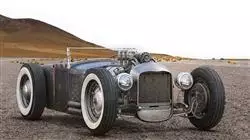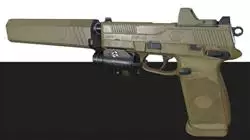University certificate
The world's largest faculty of information technology”
Introduction to the Program
Apply yourself in three-dimensional Hard Surface modeling to tackle any new professional challenge in this field with this fully online educational plan”

Hard Surface modeling allows, through texturing, lighting and rendering, to create any three-dimensional element from scratch, therefore, a hard surface modeler has the ability to create three-dimensional objects from scratch and give them a good finish. Nowadays, it is a skill required by a growing sector and it is also rewarded, since it allows the delivery a realistic idea of what the project will be in the physical dimension.
This Masters Degree in 3D Hard Surface Modeling covers all the necessary elements for the study of the shape and the analysis of the composition, which allows you to generate a realistic modeling of any object. From the most technical to the most artistic issues, you will learn about the different fields in which this discipline is applicable, such as commercial animation, aeronautical engineering, and the automotive sector, among others.
The educational plan begins with the conceptualization and theorization of key issues such as the study of the figure and shape, knowing in detail the development of the original figures and how, from them, different geometric bodies can be created. It continues to delve into the applicable modeling techniques and their principles, which will favor the development of the criteria for mapping and 3D mesh texturing, an indispensable element in three-dimensional Hard Surface modeling.
The student will also learn to perform advanced technical modeling in Rihno, one of the most popular pieces of software in the design world, which allows the creation of unimaginable shapes with great precision and detail. Finally, special emphasis will be placed on the production of characters using Hard Surface, understanding the parameters for sculpting them.
This Masters Degree is taught online, the ideal option to balance the updating of knowledge with other personal and professional projects. In addition, it has the support and backing of a faculty made up of experts of the highest prestige in three-dimensional modeling with Hard Surface.
A Masters Degree in 3D Hard Surface Modeling that will give you the keys to become a true expert in the field”
This Masters Degree in 3D Hard Surface Modeling contains the most complete and up-to-date program on the market. Its most notable features are:
- The development of case studies presented by experts in 3D Hard Surface Modeling
- The graphic, schematic, and practical contents with which they are created, provide practical information on the disciplines that are essential for professional practice
- Practical exercises where self-assessment can be used to improve learning
- Its special emphasis on innovative methodologies
- Theoretical lessons, questions to the expert, debate forums on controversial topics, and individual reflection assignments
- Content that is accessible from any fixed or portable device with an Internet connection
With a faculty made up of experts of the highest prestige in their field, this Masters Degree is what you need to know everything related to three-dimensional Hard Surface modeling”
The program includes, in its teaching staff, professionals from the sector who bring to this program the experience of their work, in addition to recognized specialists from prestigious reference societies and universities.
The multimedia content, developed with the latest educational technology, will provide the professional with situated and contextual learning, i.e., a simulated environment that will provide immersive education programmed to learn in real situations.
This program is designed around Problem-Based Learning, whereby the professional must try to solve the different professional practice situations that arise throughout the program. For this purpose, the student will be assisted by an innovative interactive video system created by renowned and experienced experts.
A fully online program that favors the autonomous learning of the student and focuses on the development of practical skills and abilities"

Apply yourself in the best and most cutting-edge three-dimensional Hard Surface modeling software with this Masters Degree"
Why study at TECH?
TECH is the world’s largest online university. With an impressive catalog of more than 14,000 university programs available in 11 languages, it is positioned as a leader in employability, with a 99% job placement rate. In addition, it relies on an enormous faculty of more than 6,000 professors of the highest international renown.

Study at the world's largest online university and guarantee your professional success. The future starts at TECH”
The world’s best online university according to FORBES
The prestigious Forbes magazine, specialized in business and finance, has highlighted TECH as “the world's best online university” This is what they have recently stated in an article in their digital edition in which they echo the success story of this institution, “thanks to the academic offer it provides, the selection of its teaching staff, and an innovative learning method aimed at educating the professionals of the future”
A revolutionary study method, a cutting-edge faculty and a practical focus: the key to TECH's success.
The most complete study plans on the university scene
TECH offers the most complete study plans on the university scene, with syllabuses that cover fundamental concepts and, at the same time, the main scientific advances in their specific scientific areas. In addition, these programs are continuously being updated to guarantee students the academic vanguard and the most in-demand professional skills. In this way, the university's qualifications provide its graduates with a significant advantage to propel their careers to success.
TECH offers the most comprehensive and intensive study plans on the current university scene.
A world-class teaching staff
TECH's teaching staff is made up of more than 6,000 professors with the highest international recognition. Professors, researchers and top executives of multinational companies, including Isaiah Covington, performance coach of the Boston Celtics; Magda Romanska, principal investigator at Harvard MetaLAB; Ignacio Wistumba, chairman of the department of translational molecular pathology at MD Anderson Cancer Center; and D.W. Pine, creative director of TIME magazine, among others.
Internationally renowned experts, specialized in different branches of Health, Technology, Communication and Business, form part of the TECH faculty.
A unique learning method
TECH is the first university to use Relearning in all its programs. It is the best online learning methodology, accredited with international teaching quality certifications, provided by prestigious educational agencies. In addition, this disruptive educational model is complemented with the “Case Method”, thereby setting up a unique online teaching strategy. Innovative teaching resources are also implemented, including detailed videos, infographics and interactive summaries.
TECH combines Relearning and the Case Method in all its university programs to guarantee excellent theoretical and practical learning, studying whenever and wherever you want.
The world's largest online university
TECH is the world’s largest online university. We are the largest educational institution, with the best and widest online educational catalog, one hundred percent online and covering the vast majority of areas of knowledge. We offer a large selection of our own degrees and accredited online undergraduate and postgraduate degrees. In total, more than 14,000 university degrees, in eleven different languages, make us the largest educational largest in the world.
TECH has the world's most extensive catalog of academic and official programs, available in more than 11 languages.
Google Premier Partner
The American technology giant has awarded TECH the Google Google Premier Partner badge. This award, which is only available to 3% of the world's companies, highlights the efficient, flexible and tailored experience that this university provides to students. The recognition as a Google Premier Partner not only accredits the maximum rigor, performance and investment in TECH's digital infrastructures, but also places this university as one of the world's leading technology companies.
Google has positioned TECH in the top 3% of the world's most important technology companies by awarding it its Google Premier Partner badge.
The official online university of the NBA
TECH is the official online university of the NBA. Thanks to our agreement with the biggest league in basketball, we offer our students exclusive university programs, as well as a wide variety of educational resources focused on the business of the league and other areas of the sports industry. Each program is made up of a uniquely designed syllabus and features exceptional guest hosts: professionals with a distinguished sports background who will offer their expertise on the most relevant topics.
TECH has been selected by the NBA, the world's top basketball league, as its official online university.
The top-rated university by its students
Students have positioned TECH as the world's top-rated university on the main review websites, with a highest rating of 4.9 out of 5, obtained from more than 1,000 reviews. These results consolidate TECH as the benchmark university institution at an international level, reflecting the excellence and positive impact of its educational model.” reflecting the excellence and positive impact of its educational model.”
TECH is the world’s top-rated university by its students.
Leaders in employability
TECH has managed to become the leading university in employability. 99% of its students obtain jobs in the academic field they have studied, within one year of completing any of the university's programs. A similar number achieve immediate career enhancement. All this thanks to a study methodology that bases its effectiveness on the acquisition of practical skills, which are absolutely necessary for professional development.
99% of TECH graduates find a job within a year of completing their studies.
Master's Degree in 3D Hard Surface Modeling
Hard Surface modeling is a technique that, through the application of textures, lighting, and rendering, allows the creation of any three-dimensional object from scratch. In this way, specialized modelers in this technique can shape and finish any element they wish to build. Currently, this skill is highly valued and in constant demand in the market, as it allows projects to be presented with a realistic and detailed representation of what is expected to be obtained in the physical dimension. The Master's Degree in Hard Surface 3D Modeling provides a comprehensive journey through all the aspects necessary to master this technique and create first-class 3D models of any object. As a result, it offers the opportunity to acquire the skills needed to develop as a professional in the field of 3D modeling and stand out in a highly competitive and ever-evolving market.
Specialize in Hard Surface 3D Modeling and boost your professional career
The Master's Degree in Hard Surface 3D Modeling allows you to delve into the study of shape and form, the development of primary shapes to create different geometric bodies, or techniques for mesh mapping and texturing. The program also includes advanced learning in technical modeling using Rhino, one of the most popular software tools in the design world, which enables the generation of precise and detailed shapes. This degree is offered in an online format, making it ideal for those who wish to update their knowledge while working on other personal or professional projects. Additionally, it is supported by a team of highly prestigious experts in 3D modeling with Hard Surface, ensuring quality education based on the latest trends in the industry.







